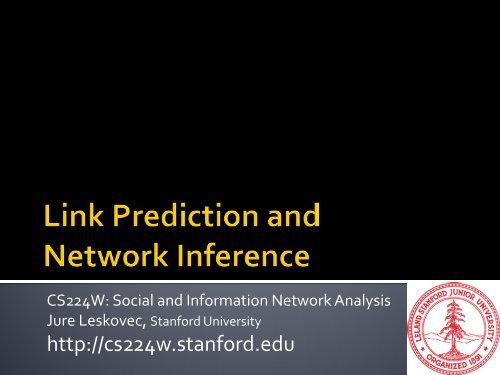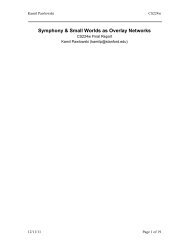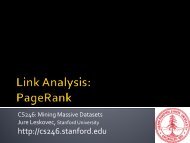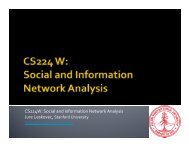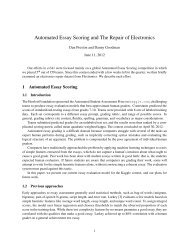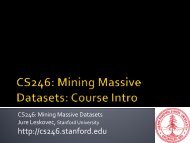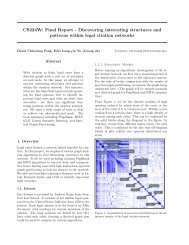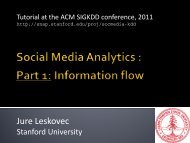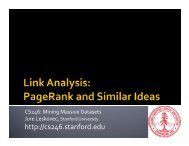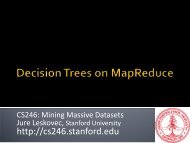You also want an ePaper? Increase the reach of your titles
YUMPU automatically turns print PDFs into web optimized ePapers that Google loves.
CS224W: Social and Information Network Analysis<br />
Jure Leskovec, <strong>Stanford</strong> <strong>University</strong><br />
http://cs224w.stanford.edu
The link prediction task:<br />
Given G[t 0,t 0’] a graph on edges<br />
up to time t 0’ output a ranked list L<br />
of links (not in G[t 0,t 0’]) that are<br />
predicted to appear in G[t 1,t 1’]<br />
Evaluation:<br />
n=|E new|: # new edges that appear during<br />
the test period [t 1,t 1’]<br />
[LibenNowell-Kleinberg ‘03]<br />
Take top n elements of L and count correct edges<br />
12/6/2011 Jure Leskovec, <strong>Stanford</strong> CS224W: Social and Information Network Analysis, http://cs224w.stanford.edu 2
Predict links in a evolving collaboration<br />
network<br />
Core: Since network data is very sparse<br />
Consider only nodes with in-degree and<br />
out-degree of at least 3<br />
[LibenNowell-Kleinberg ‘03]<br />
12/6/2011 Jure Leskovec, <strong>Stanford</strong> CS224W: Social and Information Network Analysis, http://cs224w.stanford.edu 3
Methodology:<br />
For every pair of nodes (x,y) compute proximity c<br />
# of common neighbors c(x,y) of x and y<br />
Sort pairs by the decreasing score<br />
<br />
(only condier/predict edges where both<br />
endpoints are in the core)<br />
Predict top n pairs as new links<br />
12/6/2011 Jure Leskovec, <strong>Stanford</strong> CS224W: Social and Information Network Analysis, http://cs224w.stanford.edu 4<br />
X
For every pair of nodes (x,y) compute:<br />
Γ(x) … degree of node x<br />
[LibenNowell-Kleinberg ‘03]<br />
12/6/2011 Jure Leskovec, <strong>Stanford</strong> CS224W: Social and Information Network Analysis, http://cs224w.stanford.edu 5
[LibenNowell-Kleinberg ’ 03]<br />
12/6/2011 Jure Leskovec, <strong>Stanford</strong> CS224W: Social and Information Network Analysis, http://cs224w.stanford.edu 6
Improvement over #common neighbors<br />
12/6/2011 Jure Leskovec, <strong>Stanford</strong> CS224W: Social and Information Network Analysis, http://cs224w.stanford.edu 7
How to learn to predict new friends?<br />
Facebook’s People You May Know<br />
Let’s look at the data:<br />
92% of new friendships on<br />
FB are friend-of-a-friend<br />
More common friends helps<br />
v<br />
u<br />
w<br />
z<br />
[WSDM ‘11]<br />
12/6/2011 Jure Leskovec, <strong>Stanford</strong> CS224W: Social and Information Network Analysis, http://cs224w.stanford.edu 8
Recommend a list of possible friends<br />
Supervised machine learning setting:<br />
Training example:<br />
For every node s have a list of nodes she will<br />
create links to {v 1 … v k}<br />
Task:<br />
Use FB network from May 2011 and {v 1…v k}<br />
are the new friendships you created since then<br />
For a given node s rank nodes {v 1 … v k}<br />
higher than other nodes in the network<br />
Supervised Random Walks based on<br />
work by Agarwal&Chakrabarti<br />
12/6/2011 Jure Leskovec, <strong>Stanford</strong> CS224W: Social and Information Network Analysis, http://cs224w.stanford.edu<br />
s<br />
“positive” nodes<br />
“negative” nodes<br />
Green nodes<br />
are the nodes<br />
to which s<br />
creates links in<br />
the future<br />
9
How to combine node/edge attributes and<br />
the network structure?<br />
Learn a strength of each edge based on:<br />
Profile of user u, profile of user v<br />
Interaction history of u and v<br />
Do a PageRank-like random walk<br />
from s to measure the “proximity”<br />
between s and other nodes<br />
Rank nodes by their “proximity”<br />
(i.e., visiting prob.)<br />
12/6/2011 Jure Leskovec, <strong>Stanford</strong> CS224W: Social and Information Network Analysis, http://cs224w.stanford.edu 10<br />
s <br />
s<br />
“positive” nodes<br />
“negative” nodes
Let s be the center node<br />
Let f w(u,v) be a function that assigns<br />
a strength to each edge:<br />
a uv = f β(u,v) = exp(-β T Ψ uv)<br />
Ψ uv is a feature vector<br />
Features of node u<br />
Features of node v<br />
Features of edge (u,v)<br />
[WSDM ’11]<br />
“positive” nodes<br />
“negative” nodes<br />
(β is the parameter vector we want to learn!)<br />
Do Random Walk with Restarts from s where<br />
transitions are according to edge strengths a uv<br />
12/6/2011 Jure Leskovec, <strong>Stanford</strong> CS224W: Social and Information Network Analysis, http://cs224w.stanford.edu 11<br />
s
s<br />
Network<br />
How to estimate edge strengths?<br />
How to set parameters β of f β(u,v)?<br />
s<br />
Set edge<br />
strengths<br />
a uv = f β(u,v)<br />
Personalized<br />
PageRank on the<br />
weighted graph.<br />
Each node u gets a<br />
PageRank proximity p u<br />
Sort nodes by the<br />
decreasing PageRank<br />
proximity p u<br />
Recommend top k<br />
nodes with the highest<br />
proximity p u to node s<br />
12/6/2011 Jure Leskovec, <strong>Stanford</strong> CS224W: Social and Information Network Analysis, http://cs224w.stanford.edu 12
a uv …. Strength of edge (u,v,)<br />
Random walk transition matrix:<br />
PageRank transition matrix:<br />
with prob. α jump back to s<br />
Compute PageRank vector: p = p T Q<br />
Rank nodes u by p u<br />
[WSDM ’11]<br />
“positive” nodes<br />
“negative” nodes<br />
12/6/2011 Jure Leskovec, <strong>Stanford</strong> CS224W: Social and Information Network Analysis, http://cs224w.stanford.edu 13<br />
s
Each node u has a score p u<br />
Positive nodes D ={d 1,…, d k}<br />
Negative nodes L = {the rest}<br />
What do we want?<br />
Want to find β such that p l < p d<br />
The exact solution to the above problem may not exist<br />
So we make the constrains “soft” (i.e., optional)<br />
12/6/2011 Jure Leskovec, <strong>Stanford</strong> CS224W: Social and Information Network Analysis, http://cs224w.stanford.edu<br />
[WSDM ’11]<br />
s<br />
“positive” nodes<br />
“negative” nodes<br />
14
Want to minimize:<br />
Loss: h(x)=0 if x p d<br />
12/6/2011 Jure Leskovec, <strong>Stanford</strong> CS224W: Social and Information Network Analysis, http://cs224w.stanford.edu<br />
[WSDM ’11]<br />
15
How to minimize F?<br />
Both p l and p d depend on β<br />
Given β assign edge weights auv=fβ(u,v) Using transition matrix Q=[auv] compute PageRank scores pu Rank nodes by the PageRank score<br />
Want to find β such that p l < p d<br />
12/6/2011 Jure Leskovec, <strong>Stanford</strong> CS224W: Social and Information Network Analysis, http://cs224w.stanford.edu<br />
[WSDM ’11]<br />
s<br />
16
How to minimize F?<br />
Take the derivative!<br />
We know:<br />
So:<br />
i.e.<br />
Looks like the PageRank equation!<br />
Easy<br />
[WSDM ’11]<br />
12/6/2011 Jure Leskovec, <strong>Stanford</strong> CS224W: Social and Information Network Analysis, http://cs224w.stanford.edu 17
To optimize F, use gradient based method:<br />
Pick a random starting point β 0<br />
Compute the personalized PageRank vector p<br />
Compute the gradient with respect<br />
to the weight vector β<br />
Update β<br />
Optimize using<br />
quasi-Newton<br />
method<br />
12/6/2011 Jure Leskovec, <strong>Stanford</strong> CS224W: Social and Information Network Analysis, http://cs224w.stanford.edu 18
Facebook Iceland network<br />
174,000 nodes (55% of population)<br />
Avg. degree 168<br />
Avg. person added 26 friends/month<br />
For every node s:<br />
Positive examples:<br />
D={ new friendships of s created in Nov ‘09 }<br />
Negative examples:<br />
L={ other nodes s did not create new links to }<br />
Limit to friends of friends:<br />
on avg. there are 20k FoFs (max 2M)!<br />
12/6/2011 Jure Leskovec, <strong>Stanford</strong> CS224W: Social and Information Network Analysis, http://cs224w.stanford.edu<br />
[WSDM ’11]<br />
s<br />
19
Node and Edge features for learning:<br />
Node: Age, Gender, Degree<br />
Edge: Age of an edge, Communication, Profile<br />
visits, Co-tagged photos<br />
Baselines:<br />
Decision trees and logistic regression:<br />
Above features + 10 network features (PageRank,<br />
common friends)<br />
Evaluation:<br />
AUC and Precision at Top20<br />
12/6/2011 Jure Leskovec, <strong>Stanford</strong> CS224W: Social and Information Network Analysis, http://cs224w.stanford.edu 20
Facebook:<br />
predict future<br />
friends<br />
Adamic-Adar<br />
already works<br />
great<br />
Logistic regression<br />
also strong<br />
SRW gives slight<br />
improvement<br />
12/6/2011 Jure Leskovec, <strong>Stanford</strong> CS224W: Social and Information Network Analysis, http://cs224w.stanford.edu<br />
21
Many networks are implicit or hard to observe:<br />
Hidden/hard-to-reach populations:<br />
Network of needle sharing between drug injection users<br />
Implicit connections:<br />
Network of information propagation in online news media<br />
But we can observe results of the processes<br />
taking place on such (invisible) networks:<br />
Virus propagation:<br />
Drug users get sick, and we observe when they see the doctor<br />
Information networks:<br />
We observe when media sites mention information<br />
Question: Can we infer the hidden networks?<br />
12/6/2011 Jure Leskovec, <strong>Stanford</strong> CS224W: Social and Information Network Analysis, http://cs224w.stanford.edu 24
There is a hidden diffusion network:<br />
a b<br />
c<br />
e<br />
We only see times when nodes get “infected”:<br />
Cascade c1: (a,1), (c,2), (b,3), (e,4)<br />
Cascade c2: (c,1), (a,4), (b,5), (d,6)<br />
Want to infer who-infects-whom network!<br />
12/6/2011 Jure Leskovec, <strong>Stanford</strong> CS224W: Social and Information Network Analysis, http://cs224w.stanford.edu<br />
d<br />
[KDD ’10, NIPS ‘10]<br />
25
Process<br />
We observe<br />
It’s hidden<br />
Virus propagation<br />
Viruses propagate<br />
through the network<br />
We only observe when<br />
people get sick<br />
But NOT who infected<br />
whom<br />
Word of mouth &<br />
Viral marketing<br />
Recommendations and<br />
influence propagate<br />
We only observe when<br />
people buy products<br />
But NOT who influenced<br />
whom<br />
Can we infer the underlying network?<br />
12/6/2011 Jure Leskovec, <strong>Stanford</strong> CS224W: Social and Information Network Analysis, http://cs224w.stanford.edu<br />
26
12/6/2011 Jure Leskovec, <strong>Stanford</strong> CS224W: Social and Information Network Analysis, http://cs224w.stanford.edu 27
Goal: Find a graph G that best explains the<br />
observed information times<br />
Given a graph G, define the likelihood P(C|G):<br />
Define a model of information diffusion over a graph<br />
P c(u,v) … prob. that u infects v in cascade c<br />
P(c|T) … prob. that c spread in particular pattern T<br />
P(c|G) … prob. that cascade c occurred in G<br />
P(G|C) … prob. that a set of cascades C occurred in G<br />
Questions:<br />
How to efficiently compute P(G|C)? (given a single G)<br />
How to efficiently find G * that maximizes P(G|C)?<br />
(over O(2 N*N ) graphs)<br />
12/6/2011<br />
Jure Leskovec, <strong>Stanford</strong> CS224W: Social and Information Network Analysis, http://cs224w.stanford.edu 28
Continuous time cascade diffusion model:<br />
Cascade c reaches node u at t u<br />
and spreads to u’s neighbors:<br />
With probability β cascade propagates along edge (u, v)<br />
and we determine the infection time of node v<br />
t v = t u + Δ<br />
e.g.: Δ ~ Exponential or Power-law<br />
t u t b t c<br />
Δ 1 Δ 2<br />
u a b<br />
c<br />
d<br />
We assume each node<br />
v has only one parent!<br />
12/6/2011 Jure Leskovec, <strong>Stanford</strong> CS224W: Social and Information Network Analysis, http://cs224w.stanford.edu 29
The model for 1 cascade:<br />
Cascade reaches node u at time t u,<br />
and spreads to u’s neighbors v:<br />
With prob. β cascade propagates<br />
along edge (u,v) and t v = t u+Δ<br />
Transmission probability:<br />
P c(u,v) ∝ P(t v -t u ) if t v> t u else ε<br />
e.g.: P c(u,v) ∝ e -Δt<br />
ε captures influence external to the network<br />
At any time a node can get infected from outside<br />
with small probability ε<br />
12/6/2011 Jure Leskovec, <strong>Stanford</strong> CS224W: Social and Information Network Analysis, http://cs224w.stanford.edu 30<br />
β<br />
a<br />
c<br />
ε<br />
e<br />
tv<br />
ε<br />
b<br />
ε<br />
d
Given node infection times and pattern T:<br />
c = { (a,1), (c,2), (b,3), (e,4) }<br />
T = { a→b, a→c, b→e }<br />
Prob. that c propagates in pattern T<br />
Edges that “propagated” Edges that failed to “propagate”<br />
Approximate it as:<br />
12/6/2011<br />
Jure Leskovec, <strong>Stanford</strong> CS224W: Social and Information Network Analysis, http://cs224w.stanford.edu<br />
a<br />
c<br />
T<br />
e<br />
b<br />
Graph G<br />
31<br />
d
How likely is cascade c to spread in graph G?<br />
c = {(a,1), (c,2), (b,3), (e,4)}<br />
a<br />
c<br />
e<br />
b<br />
d<br />
Need to consider all possible ways for c to<br />
spread over G (i.e., all spanning trees T):<br />
a<br />
c<br />
e<br />
b<br />
d<br />
Consider only the most likely propagation tree<br />
12/6/2011 Jure Leskovec, <strong>Stanford</strong> CS224W: Social and Information Network Analysis, http://cs224w.stanford.edu<br />
a<br />
c<br />
e<br />
b<br />
d<br />
32
Score of a graph G for a set of cascades C:<br />
Want to find the “best” graph:<br />
The problem is NP-hard:<br />
MAX-k-COVER [KDD ’10]<br />
12/6/2011 Jure Leskovec, <strong>Stanford</strong> CS224W: Social and Information Network Analysis, http://cs224w.stanford.edu 33
Given a cascade c, what is the most likely<br />
propagation tree?<br />
A maximum directed spanning tree<br />
Edge (i,j) in G has weight wc(i,j)=log Pc(i,j) The maximum weight spanning tree on<br />
infected nodes: Each node picks an in-edge of<br />
max weight:<br />
Local greedy selection gives optimal tree!<br />
12/6/2011 Jure Leskovec, <strong>Stanford</strong> CS224W: Social and Information Network Analysis, http://cs224w.stanford.edu<br />
a<br />
c<br />
e<br />
b<br />
d<br />
34
Theorem:<br />
F c(G) is monotonic, and submodular<br />
Proof:<br />
Single cascade c, some edge e=(r,s) of weight. w rs<br />
Show F c(G∪ {e}) – F c(G) ≥ F c(G’∪ {e}) – F C (G’)<br />
Let w .s be max weight in-edge of s in G<br />
Let w’ .s be max weight in-edge of s in G’<br />
Since G ⊆ G’ : w .s ≤ w’ .s and w rs= w’ rs
The algorithm:<br />
Use greedy hill-climbing to maximize F C(G):<br />
Start with empty G 0 (G with no edges)<br />
Add k edges (k is parameter)<br />
At every step i add an edge to G i that<br />
maximizes the marginal improvement<br />
12/6/2011 Jure Leskovec, <strong>Stanford</strong> CS224W: Social and Information Network Analysis, http://cs224w.stanford.edu<br />
[KDD ’10]<br />
36
Synthetic data:<br />
Take a graph G on k edges<br />
Simulate info. diffusion<br />
Record node infection times<br />
Reconstruct G<br />
Evaluation:<br />
How many edges of G<br />
can NetInf find?<br />
Break-even point: 0.95<br />
Performance is independent<br />
of the structure of G!<br />
12/6/2011 Jure Leskovec, <strong>Stanford</strong> CS224W: Social and Information Network Analysis, http://cs224w.stanford.edu<br />
37
We achieve ≈ 90 % of the best possible<br />
network!<br />
12/6/2011 Jure Leskovec, <strong>Stanford</strong> CS224W: Social and Information Network Analysis, http://cs224w.stanford.edu 38
With 2x as many infections as edges,<br />
the break-even point is already 0.8 - 0.9!<br />
12/6/2011 Jure Leskovec, <strong>Stanford</strong> CS224W: Social and Information Network Analysis, http://cs224w.stanford.edu 39
Memetracker dataset:<br />
172m news articles<br />
Aug ‘08 – Sept ‘09<br />
343m textual phrases<br />
Times t c(w) when site<br />
w mentions phrase c<br />
Given times when sites mention phrases<br />
Infer the network of information diffusion:<br />
Who tends to copy (repeat after) whom<br />
http://memetracker.org<br />
12/6/2011 Jure Leskovec, <strong>Stanford</strong> CS224W: Social and Information Network Analysis, http://cs224w.stanford.edu<br />
[KDD, ‘09]<br />
40
5,000 news sites:<br />
Blogs<br />
Mainstream media<br />
12/6/2011 Jure Leskovec, <strong>Stanford</strong> CS224W: Social and Information Network Analysis, http://cs224w.stanford.edu<br />
41
Blogs<br />
Mainstream media<br />
12/6/2011 Jure Leskovec, <strong>Stanford</strong> CS224W: Social and Information Network Analysis, http://cs224w.stanford.edu<br />
42


